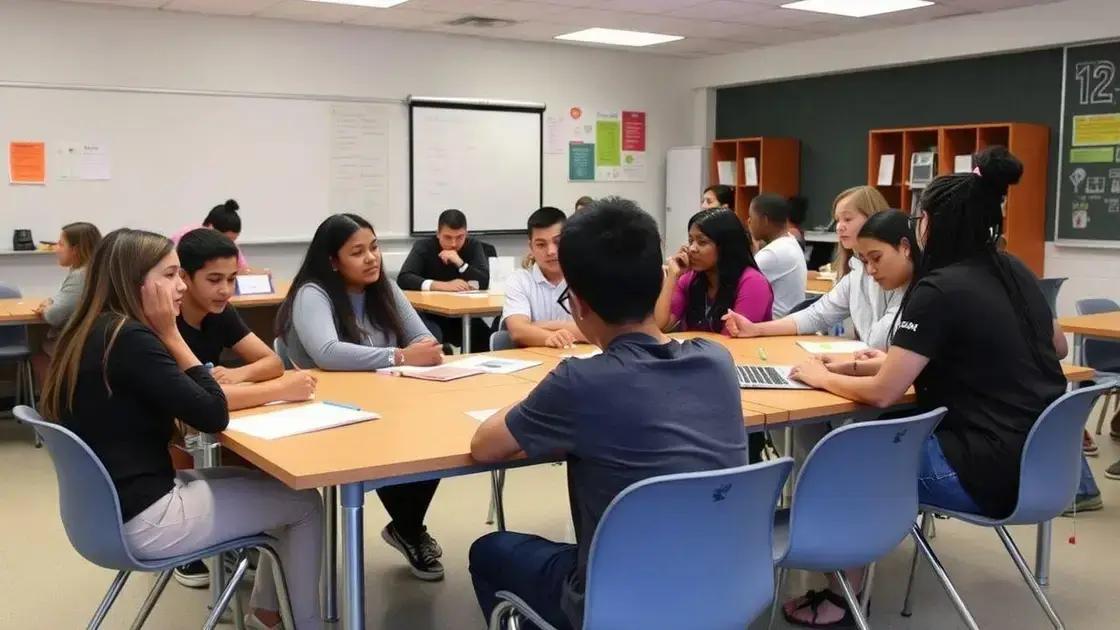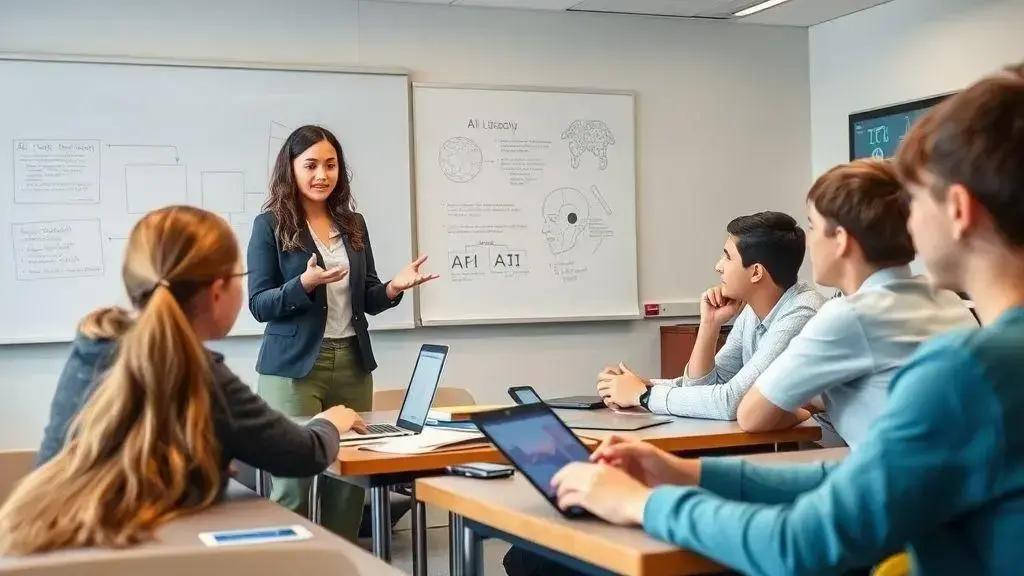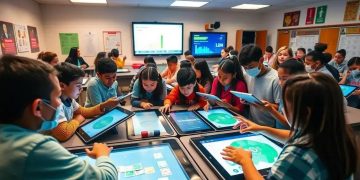Generative AI literacy initiatives in U.S. schools
Generative AI literacy initiatives in U.S. schools prepare students for the future by integrating AI concepts into the curriculum, fostering critical thinking, and providing hands-on learning experiences.
Generative AI literacy initiatives in U.S. schools are transforming how students engage with technology. Curious about how this impacts learning? Let’s dive into the exciting world of AI education.
Understanding generative AI and its importance
Understanding generative AI is essential in today’s digital age. This technology allows machines to create content, from text to images, revolutionizing various sectors. By grasping the importance of generative AI, students can navigate the future more effectively.
What is Generative AI?
Generative AI refers to algorithms that can generate realistic outputs based on input data. These outputs can include articles, music, and even paintings. The ability of AI systems to produce human-like content is groundbreaking.
Why is Generative AI Important?
This technology is not just a trend; it’s shaping our world. Here are a few reasons why understanding it is crucial:
- Career opportunities: Familiarity with AI can enhance job prospects in various fields.
- Creative potential: Artists and writers can leverage AI to inspire and create new works.
- Problem-solving: AI can tackle complex challenges, making processes more efficient.
Understanding generative AI helps students prepare for the future. As this technology advances, its applications will continue to grow, influencing industries and daily life.
As students explore generative AI, they discover new ways to think and innovate. Being informed about its potential impacts prepares young minds for a rapidly changing world.
How schools are implementing AI literacy programs

Schools across the U.S. are taking significant steps to implement AI literacy programs. These initiatives aim to equip students with the skills needed to navigate and understand the growing influence of artificial intelligence in everyday life. By incorporating AI into the curriculum, schools can prepare students for future careers in various fields.
Integrating AI into Existing Curriculum
Many schools are finding innovative ways to include AI education within their current subjects. For example, math and science classes can cover AI concepts through data analysis and programming. This integration helps students see the connection between AI technology and real-world applications.
Hands-on Learning Experiences
In addition to classroom learning, hands-on experiences are crucial in teaching AI. Schools are offering:
- Workshops: These events allow students to interact with AI tools and learn from experts.
- Project-based learning: Students can collaborate on projects that require using AI systems, enhancing critical thinking skills.
- Field trips: Visiting tech companies provides students insight into how AI is used in various industries.
Through these methods, schools make AI engaging and accessible. Students are not only learning theory but also practicing their skills in practical settings.
Collaboration with tech companies is also vital. By partnering with local businesses, schools can offer students opportunities to work on real-world AI challenges. This collaboration enhances the students’ learning experience and prepares them for future employment.
Challenges faced in teaching AI concepts
Teaching AI concepts in schools brings unique challenges that educators must navigate. Understanding these obstacles can help improve the effectiveness of AI literacy programs. One significant challenge is the rapid pace of technological advancement. As AI evolves, keeping curriculum materials up-to-date becomes essential yet difficult.
Complexity of AI Topics
AI concepts can be complex and abstract. For many students, grasping the fundamentals of machine learning or algorithms requires significant effort. To overcome this, teachers often need to simplify concepts without losing their essence. This balance is crucial for ensuring that students develop a solid understanding of artificial intelligence.
Limited Resources
Another challenge lies in the availability of resources. Many schools lack access to the latest tools and technologies that facilitate AI education. This gap can lead to disparities in learning opportunities. Schools must find creative ways to use existing resources while seeking partnerships to enhance their programs.
- Funding: Many schools face budget constraints that limit access to new technologies.
- Training: Teachers often require specific training to effectively teach AI concepts.
- Curriculum Development: Developing an effective curriculum that covers AI adequately can be time-consuming.
Additionally, teachers may feel unprepared to teach about AI due to their own limited knowledge in the subject. This can lead to hesitation in fully engaging students with these important topics. To address this, professional development and collaboration among educators are essential.
Despite the challenges, many educators are committed to fostering a strong understanding of AI among students. Their dedication highlights the importance of nurturing future generations who can navigate and shape the world influenced by artificial intelligence.
The role of teachers in fostering AI literacy

Teachers play a vital role in fostering AI literacy among students. Their guidance and expertise create a foundation for understanding complex technology. By embracing artificial intelligence concepts, teachers help students develop critical thinking skills that are essential for their future.
Creating an Engaging Curriculum
One of the key responsibilities of educators is to create an engaging curriculum that incorporates AI topics. This can include lessons on machine learning, data ethics, and the impact of AI on society. To make learning more interactive, teachers often use:
- Real-world examples: Connecting AI concepts to everyday life helps students relate to the material.
- Hands-on activities: Projects that allow students to work with AI tools make the subject matter more tangible.
- Collaborative learning: Group work encourages discussions and diverse viewpoints on AI applications.
Beyond classroom activities, teachers must also stay informed about the latest developments in AI technology. Continuous professional development ensures that educators can provide accurate and relevant information to students. They can participate in workshops, attend conferences, and engage with online communities dedicated to AI education.
Encouraging Critical Thinking
Another vital aspect of a teacher’s role is fostering critical thinking skills in students. By challenging them to analyze and question AI’s implications, teachers help students understand the ethical considerations surrounding technology. This approach encourages deeper engagement and prompts discussions about the benefits and risks of AI.
Teachers can facilitate these discussions by posing thought-provoking questions and encouraging students to explore various perspectives on AI issues. This fosters a classroom environment where students feel comfortable sharing their ideas and opinions.
As educators embrace their role in promoting AI literacy, they contribute to shaping a future generation that is not only tech-savvy but also equipped to navigate the complexities of an AI-driven world. Their commitment to teaching these essential skills lays the groundwork for students to thrive in the rapidly evolving digital landscape.
In conclusion, the role of teachers in fostering AI literacy is crucial for preparing students for the future. By integrating AI concepts into the curriculum, providing hands-on experiences, and encouraging critical thinking, educators can create a positive learning environment. The challenges of teaching AI can be overcome with dedication and support. As teachers embrace their role in this dynamic field, they empower students to navigate the complex world of artificial intelligence with confidence and skill.
FAQ – Frequently Asked Questions about AI Literacy in Schools
What is AI literacy?
AI literacy refers to understanding the concepts and implications of artificial intelligence. It helps students navigate a technology-driven world.
How can teachers effectively teach AI concepts?
Teachers can effectively teach AI by integrating it into existing subjects, using hands-on activities, and promoting critical thinking discussions.
What challenges do educators face when teaching AI?
Educators face challenges such as keeping up with rapid technological changes, limited resources, and the complexity of AI topics.
Why is collaboration important among teachers in AI education?
Collaboration allows teachers to share resources, strategies, and support, enhancing the overall quality of AI education for students.





